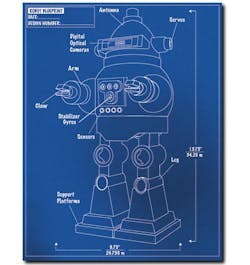But the growth will be narrowly focused, predicts Erik Nieves. “Robotizing” what’s already automated is one way, says the technology director for supplier Motoman Robotics (www.motoman.com), Waukegan, Ill., a division of Yaskawa America Inc. While that provides flexibility, “effectively, you’re just making an improvement, though probably not in reliability. You’re leveraging the flexibility that robotics affords,” he observes. Whatever changes, though, robotizing of already automated functions “is not going to be the ‘sea change’ in our industry.”Another trend he sees, unified control, could be part of such change. In this control infrastructure, especially in emerging markets that haven’t existed long enough to assume separate controls is correct, “you make a decision about who’s responsible for everything,” Nieves explains. “Can I program not just the robot with the robot controller but all the peripherals?” If so, there won’t be a programmable logic controller (PLC) involved, he continues. This control unification for robots hasn’t yet hit the factory floor, he says, but it’s coming.What Nieves considers the real “sea change” is dual-armed robots. These perform tasks with the dexterity previously possible only with humans, he comments. The big leap was not from a single-arm to a dual-arm robot, though, he asserts. “That was natural. The leap was from six to seven axes. Once you have a seven-axis arm and you have all this dexterity, then it is very organic to apply two seven-axis arms to a common torso.” And that, Nieves states, was how the dual-arm robot was born.The seven-axis arm allows movement without affecting position and orientation, he adds. And such dual-arm robots provide gains in productivity. But these robots, which are in their infancy, will never be dominant, Nieves predicts. “You will always have tasks that six-axis robots are suitable for, such as tried-and-true applications such as spot welding.”Besides more mechanical functionality, robotics’ growth also focuses more on interconnectivity and traceability, suggests Rush LaSelle, global sales and marketing director for vendor Adept Technology Inc. (www.adept.com), Pleasanton, Calif. One pathway is through information-technology clouds. This technology implies that the computing resources exist somewhere else, “out there,” and, as necessary, that users will connect. “The benefit of processing and its interrelationship with the cloud is in its relative infancy throughout manufacturing and, certainly, within the context of robotics.” But, says LaSelle, “ ‘cloud’ or resource sharing has been used in the automation industry for as long as there have been networks.”Cloud coverageAnother real-world cloud example he provides is inventory control, in which robots palletize and handle products in warehouses and distribution centers. “Inventory information is largely managed in the cloud and the addition of intelligent robotic automation acts as a vehicle to reconcile what’s ‘expected’ in the digital world—that is, what is captured in databases throughout planning and finance—and what actually ‘exists’ in the physical world—that is, pallets of products in warehouse racks,” LaSelle explains.Besides clouds, end-users will benefit from being freed of having to program robots. “Our team is evaluating technologies and developing methodologies so that users will be able to teach, not program, robots,” LaSelle states. Options he mentions include gesture-based teaching and other human-machine interfaces beyond the traditional interface on a teach pendant, programmable logic controller or personal computer.Sensory inputs comprise another growth area of value-add focus. “Portion control and product grading for the handling of primary foods, especially those in the protein category (e.g. meat, fish and poultry), are active areas of development,” LaSelle notes. What could the net benefit be? Robots will not only locate, pick and place products into packaging, he says, but will determine size of the products. That’s so the robot can place the correct weight of products into a package and conduct real-time quality control.C. Kenna Amos, [email protected], is an Automation World Contributing Editor.Motoman Roboticswww.motoman.comAdept Technology Inc.www.adept.com
Subscribe to Automation World's RSS Feeds for Columns & Departments
About the Author
C. Kenna Amos
Contributing Editor
Sign up for our eNewsletters
Get the latest news and updates

Leaders relevant to this article:
